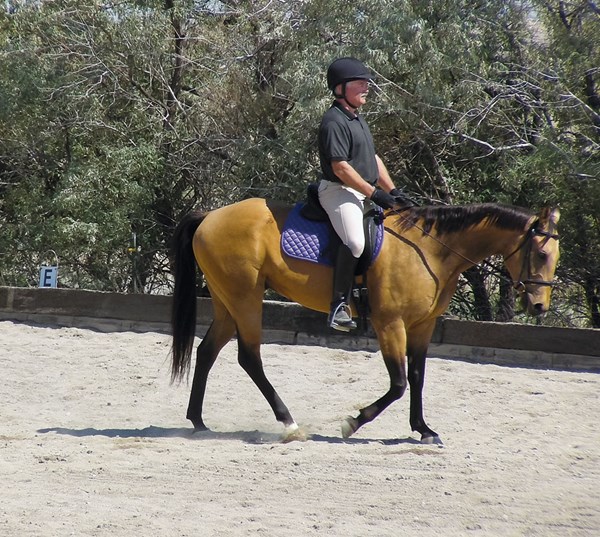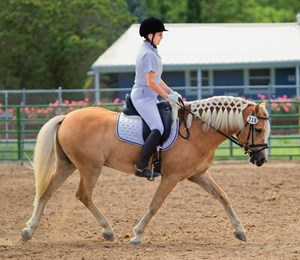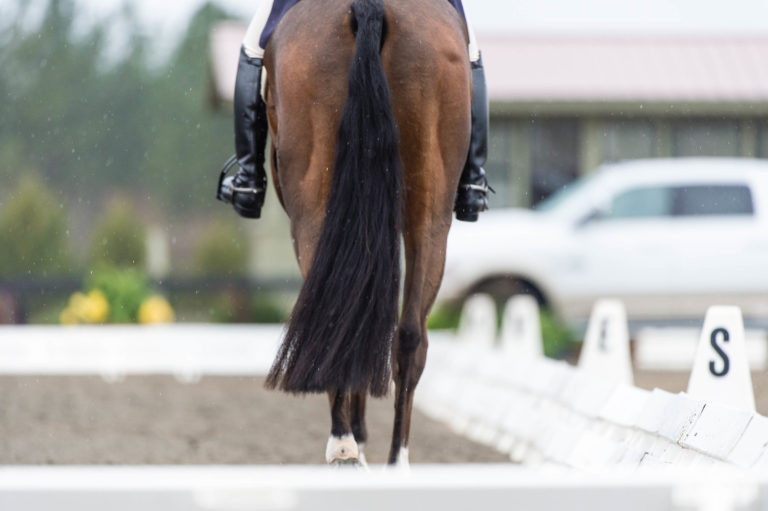
Rider 1 – Improve the Horse’s Balance Through Rider Position Changes
This is Dave O’Connell and his 7-year-old Quarter Horse, MR Fritiz Pep (aka Junior). Dave has been riding Western all his life and started training in dressage about two years ago. He and Junior have shown at Training Level, and Dave hopes to move up the levels.
The biggest problems I see between Dave and Junior are longitudinal balance and energy level. Most horses left to their own devices will opt for a balance that naturally is carried on their forehand as you see here with Junior. A horse’s head and neck already weigh a considerable amount, contributing to that natural tendency, and then without an inspired amount of energy and focus, Junior’s thoracic sling muscles will not be engaged, making his balance land on his forehand. The thoracic sling includes the trapezius, serratus ventralis, subclavius and pectorals—all muscles in the front third of the horse that are responsible for lifting the rib cage, therefore moving the horse’s balance from front to back. This is one of the rare cases in dressage that going from front to back is correct, and Junior’s center of gravity really must move in this direction with engagement of his thoracic sling. Easier said than done!
We can start with some changes in Dave’s position in our mission to change Junior’s balance. Dave has a slight hollow in his lower back, making his seat bones point back incorrectly. His pubic bone is too low and his pelvis has too much forward tilt.
Junior’s withers are too low and his downhill balance is pushing Dave onto the pommel. Dave must ride as if his horse were more level, with a more level pelvis, so Junior can match him, rather than the other way around. Dave would need to lift his pubic bone up to think of his seat bones pointing slightly more forward and to feel his lower back fill in. Because his pelvis has this forward tilt to it, Dave’s torso has more length to it along his front than his back. I would like to see his front (from his sternum to his pubic bone) be straighter and shorter, matching the length of his back, and his shoulder lined up over his seat bones (they’re slightly behind in this photo).
The relationship between Junior and Dave also shows how the balance in Junior, who is too on the forehand, takes Dave’s thighs into an outward rotation, causing his lower legs to turn his toes out and away from parallel. Dave should rotate his thigh inward so his hamstring is behind his femur and not between it and the saddle. His thighs would then be more closely connected to his horse. This would fix the position of his toes, which are pointing outward, and his heels, which are pointing toward his horse. His knees should bend enough so that his lower legs and feet stay farther back, making straight lines from his shoulders (which should be more forward) to his seat bones to his heels.
If Dave makes these simple biomechanical changes in the way he uses his body in his riding, Junior could change dramatically from that alone. Junior needs a framework, structure and boundaries from Dave’s body to give him some help in understanding how to change his own balance and framework.
Rider 2 – Developing More Carrying Power

This is Arlene Rhodes riding her 8-year-old Haflinger gelding, Wrangler SFF, in their first recognized show at First Level. She bought him two years ago as an Introductory Level horse.
This is a pleasing photo of a free moving horse with a nicely reaching, round topline and a rider doing a pretty good job of staying in her own balance. My immediate impression is that not very much is wrong other than I would like to see Wrangler carry more weight behind for First Level. First Level does not call for collection, and that is not what I expect, but his frame is slightly long and more appropriate for Training Level.
Some of the changes I would make in Arlene’s biomechanics are as follows: There’s tension in Arlene’s rib cage, which makes it seem like she might not breathe or let her center of gravity down within her torso enough. I imagine from this photo that she may ride the trot in a bit of a hurry and overtempo.
It would help the level of security and power in Arlene’s body if she felt more “bear down” within her. To feel bear down as you sit in a chair, put one hand on your abdominal muscles and the other one on your lower back muscles, then push your hands together. Next, think of using the power of your lower body to push your hands apart. Don’t hold your breath. It shouldn’t make you feel that you press any harder into the chair, just as it wouldn’t make you squash down on your horse’s back.
It’s important to realize how to make your core strong like this without it meaning that you crush your horse’s back down. It’s only a tool to help strengthen your own body’s core, stability and consistency. Bear down is not an aid to stop your horse or make him go. It’s a consistent state of being throughout your ride, from start to finish, that helps give your horse the sense that you are the leader of the dance.
Arlene did mention that her horse’s trot can be bouncy, and I would like to think that more bear down and, therefore better breathing, could help her find more control in the sitting trot. The other slight symptom of Arlene’s upper- body tension is that she carries her elbows a bit too far out from her body and that adds to her tendency
to turn her hands palms down. I would like her upper arm to lower, bringing her shoulder blades farther down and her elbows closer (but not tight) to
her sides.
I think that with repetition of some simple but prompt and frequent go–and–stop transitions, her horse’s balance will naturally change into that which can meet the demands of the transitions more frequently. Once the balance in her horse’s trot shifts back more toward the hind legs, she’ll easily be able to carry a shorter rein and have her horse in more of a First Level frame and balance. But it’s very important to make sure that the shift in balance happens first. If it does, then the beautiful quality of her horse’s reach-out into the rein will not be less, even when the frame shortens and she trains into collection for the higher levels.











